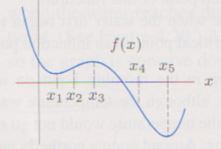Assignment:
Q1. With a yearly rate of 3 percent, prices are described as P = P0 (1.03)t, where P0 is the price in dollars when t = 0 and t is time in years. If P0 is 1.2, how fast are prices rising when t = 15?
Q2. The value of a car is falling 10 percent per year so that if C0 is the purchase price of the car in dollars, its value after t years is given by V(t) = C0(0.9)t. At what rate is its value falling when it is driven out of the showroom? How fast has the car depreciated after year 1?
Q3. The world's population is abou f(t) = 6*e0.013t billion, where t is the time in years since 1999. Find f(0), f'(0), f(0) and f'(10). Using units, interpret your answers in terms of population.
Q4. For f(x) = x^3 - 18x^2 - 10x + 6, find the inflection point algebraically. Graph the function and confirm your answer.
Q5. For the function, f, given in the graph in Figure, (a) sketch f'(x); (b) Where does f'(x) change its sign? (c) Where does f'(x) have local maxima or minima?

Q6. Using your answer to previous problem as a guide, write a short paragraph which describes the relationship between the following features of a function f:
(a) the local maxima and minima f. (b) the points at which the graph f changes concavity. (c) the sign changes of f', (d) the local maxima and minima of f'.
Q7. The function f has a derivative everywhere and has just one critical point, at x = 3. In parts (a)-(d), you are given additional conditions. In each case decide whether x = 3 is a local maximum, a local minimum, or neither. Explain your reasoning. Sketch possible graphs for all four cases.
a) f'(1) = 3 and f'(5) = -1
b) f(x) → ∞ as x → ∞ and as x → -∞
c) f(1) = 1, f(2) = 2, f(4) = 4, f(5) = 5
d) f'(2) = -1, f(3) = 1, f(x) → 3 as x →∞
Q8. An apple tree produces, on average, 400 kg of fruit each season. However, if more than 200 trees are planted per km^2, crowding reduces the yield by 1 kg for each tree over 200.
(a) Express the total yield from one square kilometer as a function of the number of trees on it. Graph the function.
(b) How many trees should a farmer plant on each square kilometer to maximize yield?
Provide complete and step by step solution for the question and show calculations and use formulas.